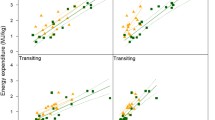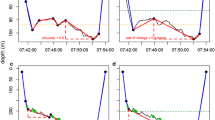Abstract
Leg-mounted loggers are increasingly used in seabird activity studies, but few studies have validated the information obtained about bird behaviour with independent data. Using Brünnich’s Guillemot Uria lomvia as a study species, we show by comparing interpretations of time–depth recorder (TDR) data with visual observations that activity budgets inferred from leg-mounted TDRs provide reliable information on colony attendance, and validate information on flight time by comparing periods interpreted as flight based on TDR data with periods interpreted as flight based on GPS speed information. Yet, special attention is needed because auks resting at sea occasionally withdraw one leg and/or foot into the plumage (leg-in-plumage). During this behaviour, the TDR may be warm and dry, potentially leading to spurious identification of colony visits. In our case study, spurious identification of colony visits would have resulted in mean trip duration being underestimated by a factor of 4, and number of trips being correspondingly overestimated. We therefore urge great care when deriving activity budgets from leg-mounted TDRs, but nonetheless recommend using leg-mounted TDRs to infer activity budgets from diving seabirds, particularly for longer deployments.
Zusammenfassung
Aktivitätsbudgets von Seevögeln anhand von am Bein befestigten Tiefenmessern
Bei Aktivitätsstudien an Seevögeln werden vermehrt am Bein befestigte Datenlogger eingesetzt, allerdings haben bislang nur wenige Studien die dadurch gewonnenen Informationen über das Verhalten der Vögel anhand von unabhängigen Daten bestätigt. Wir wählten Dickschnabellummen Uria lomvia als Untersuchungsart, um durch den Vergleich der Auswertungen von Tiefenmessern (time–depth recorder, TDR) mit Sichtbeobachtungen zu zeigen, dass Aktivitätsbudgets auf der Grundlage von an den Beinen der Vögel befestigten TDRs verlässliche Informationen über deren Anwesenheit in der Kolonie liefern und um Flugzeitangaben durch den Vergleich von an TDR-Daten ermittelten Flugphasen mit solchen, die auf der Basis von GPS-Geschwindigkeitsdaten bestimmt wurden, zu bestätigen. Trotzdem ist besondere Vorsicht angebracht, da auf See ruhende Lummen gelegentlich ein Bein beziehungsweise einen Fuß ins Gefieder ziehen. Während dieser Verhaltensweise ist der TDR unter Umständen warm und trocken und kann so zur fälschlichen Diagnose von Kolonieaufenthalten führen. In unserer Fallstudie hätte eine solche falsche Erkennung von Koloniebesuchen dazu geführt, dass die mittlere Dauer von Nahrungsflügen um den Faktor 4 zu niedrig angesetzt beziehungsweise dass umgekehrt die Anzahl der Flüge entsprechend überschätzt worden wäre. Daher möchten wir dringend zur Vorsicht raten, wenn Aktivitätsbudgets anhand von am Bein angebrachten TDRs ermittelt werden; trotzdem können wir diese zur Erstellung von Aktivitätsbudgets tauchender Seevögel, besonders über einen längeren Einsatzzeitraum, empfehlen.

Similar content being viewed by others
References
Cairns DK, Bredin KA, Montevecchi WA (1987) Activity budgets and foraging ranges of breeding Common Murres. Auk 104:218–224
Croll DA, Mclaren E (1993) Diving metabolism and thermoregulation in common and Thick-Billed Murres. J Comp Physiol B 163:160–166
Croll DA, Gaston AJ, Burger AE, Konnoff D (1992) Foraging behavior and physiological adaptation for diving in Thick-Billed Murres. Ecology 73:344–356
Elliott KH, Davoren GK, Gaston AJ (2007) The influence of buoyancy, and drag on the dive behaviour of an Arctic seabird, the Thick-billed Murre. Can J Zool 85:352–361
Elliott KH, Davoren GK, Gaston AJ (2008) Sources of bias in observations of Murre provisioning behavior. J Field Ornithol 79:298–307
Falk K, Benvenuti S, Dall’antonia L, Kampp K, Ribolini A (2000) Time allocation and foraging behaviour of chick-rearing Brünnich’s Guillemots Uria lomvia in high-arctic Greenland. Ibis 142:82–92
Harris MP, Daunt F, Newell M, Phillips RA, Wanless S (2010) Wintering areas of adult Atlantic puffins Fratercula arctica from a North Sea colony as revealed by geolocation technology. Mar Biol 157:827–836
Labansen AL, Merkel FR, Frederiksen M, Falk K, Mosbech A (2013) Monitering af lomvier og rider i det nordlige Upernavik, 2008. Teknisk Rapport Nr. 90, Pinngortitaleriffik, Grønlands Naturinstitut
Paredes R, Jones IL, Boness DJ (2005) Reduced parental care, compensatory behaviour and reproductive costs of thick-billed Murres equipped with data loggers. Anim Behav 69:197–208
Prince PA, Francis MD (1984) Activity budgets of foraging Gray-Headed Albatrosses. Condor 86:297–300
R Development Core Team (2006) R: a language and environment for statistical computing, R Foundation for Statistical Computing, Vienna, Austria
Ropert-Coudert Y, Gremillet D, Kato A, Ryan PG, Naito Y, Le Maho Y (2004) A fine-scale time budget of Cape gannets provides insights into the foraging strategies of coastal seabirds. Anim Behav 67:985–992
Takahashi A, Sato K, Naito Y, Dunn MJ, Trathan PN, Croxall JP (2004) Penguin mounted cameras glimpse underwater group behaviour. Proc R Soc Lond B 271:S281–S282
Tremblay Y, Cherel Y, Oremus M, Tveraa T, Chastel O (2003) Unconventional ventral attachment of time–depth recorders as a new method for investigating time budget and diving behaviour of seabirds. J Exp Biol 206:1929–1940
Tremblay Y, Cook TR, Cherel Y (2005) Time budget and diving behaviour of chick-rearing Crozet shags. Can J Zool 83:971–982
Wanless S, Harris MP (1986) Time spent at the colony by male and female Guillemots Uria aalge and Razorbills Alca torda. Bird Study 33:168–176
Wanless S, Morris JA, Harris MP (1988) Diving behavior of Guillemot Uria Aalge, Puffin Fratercula Arctica and Razorbill Alca Torda as shown by radio-telemetry. J Zool 216:73–81
Watanuki Y, Mehlum F, Takahashi A (2001) Water temperature sampling by foraging Brünnich’s Guillemots with bird-borne data loggers. J Avian Biol 32:189–193
Weimerskirch H, Le Corre M, Ropert-Coudert Y, Kato A, Marsac F (2005) The three-dimensional flight of red-footed boobies: adaptations to foraging in a tropical environment? Proc R Soc Lond B 272:53–61
Welcker J, Harding AMA, Karnovsky NJ, Steen H, Strom H, Gabrielsen GW (2009) Flexibility in the bimodal foraging strategy of a high Arctic alcid, the little auk Alle alle. J Avian Biol 40:388–399
Woo KJ, Elliott KH, Davidson M, Gaston AJ, Davoren GK (2008) Individual specialization in diet by a generalist marine predator reflects specialization in foraging behaviour. J Anim Ecol 77:1082–1091
Zavalaga CB, Dell’Omo G, Becciu P, Yoda K (2011) Patterns of GPS tracks suggest nocturnal foraging by incubating Peruvian Pelicans (Pelecanus thagus). PLoS ONE 6:e19966
Acknowledgments
We wish to express our gratitude to Jérôme Fort and Kelly Edmunds for useful discussions and proofreading, and Tim Guilford for providing us with GPS loggers in 2009. We also thank David Grémillet, Steve Votier and anonymous reviewers for comments on earlier drafts.
Author information
Authors and Affiliations
Corresponding author
Additional information
Communicated by C. Barbraud.
Electronic supplementary material
Below is the link to the electronic supplementary material.
Rights and permissions
About this article
Cite this article
Linnebjerg, J.F., Huffeldt, N.P., Falk, K. et al. Inferring seabird activity budgets from leg-mounted time–depth recorders. J Ornithol 155, 301–306 (2014). https://doi.org/10.1007/s10336-013-1015-7
Received:
Revised:
Accepted:
Published:
Issue Date:
DOI: https://doi.org/10.1007/s10336-013-1015-7




